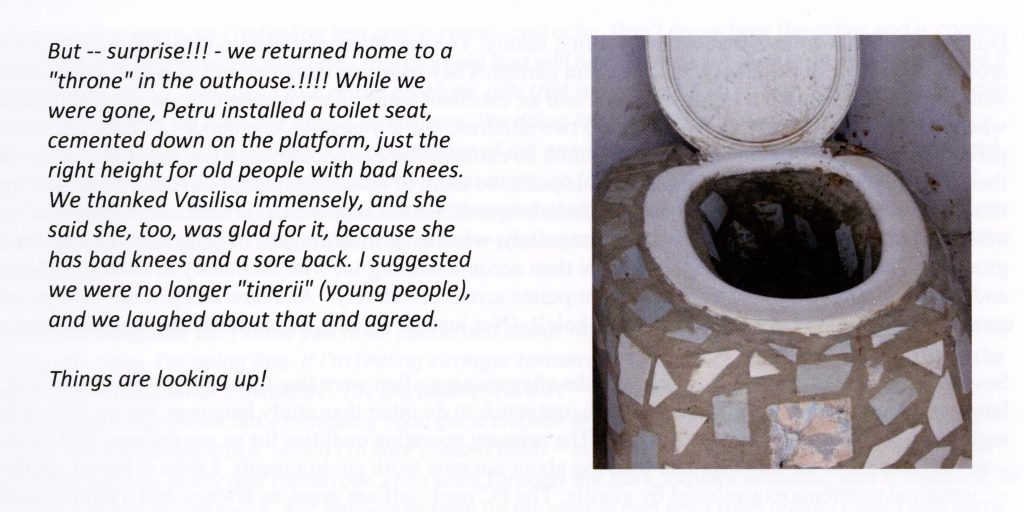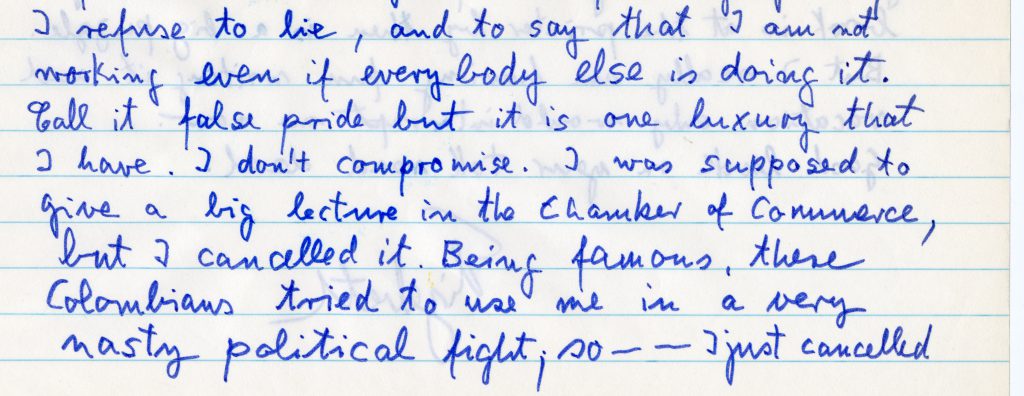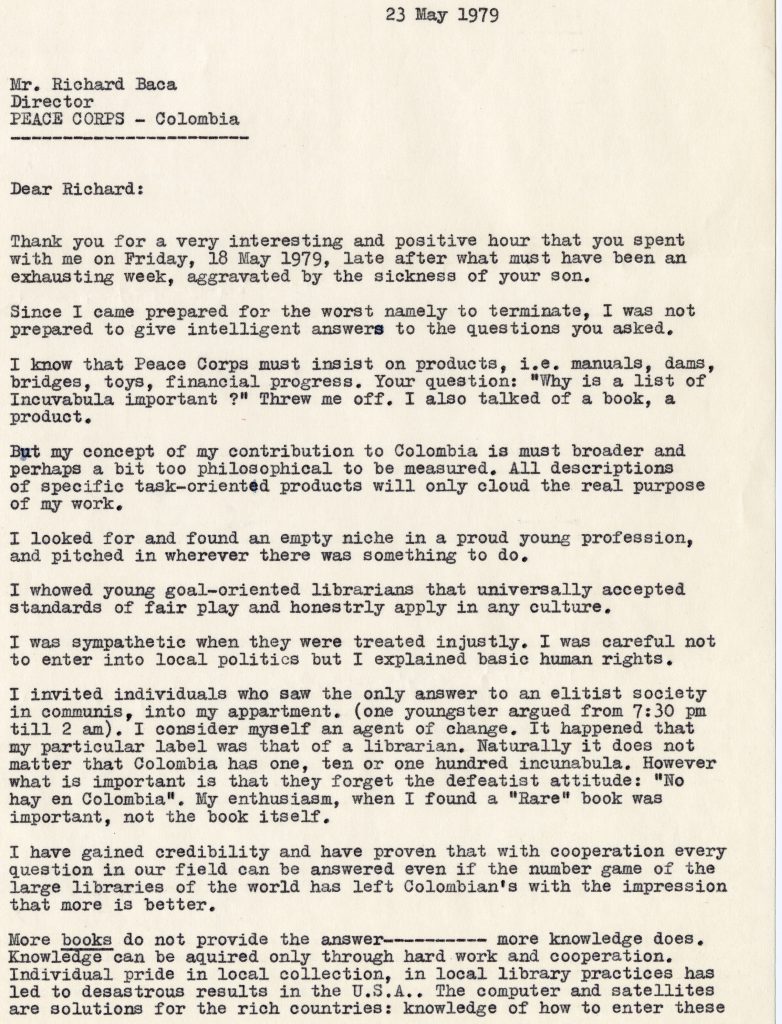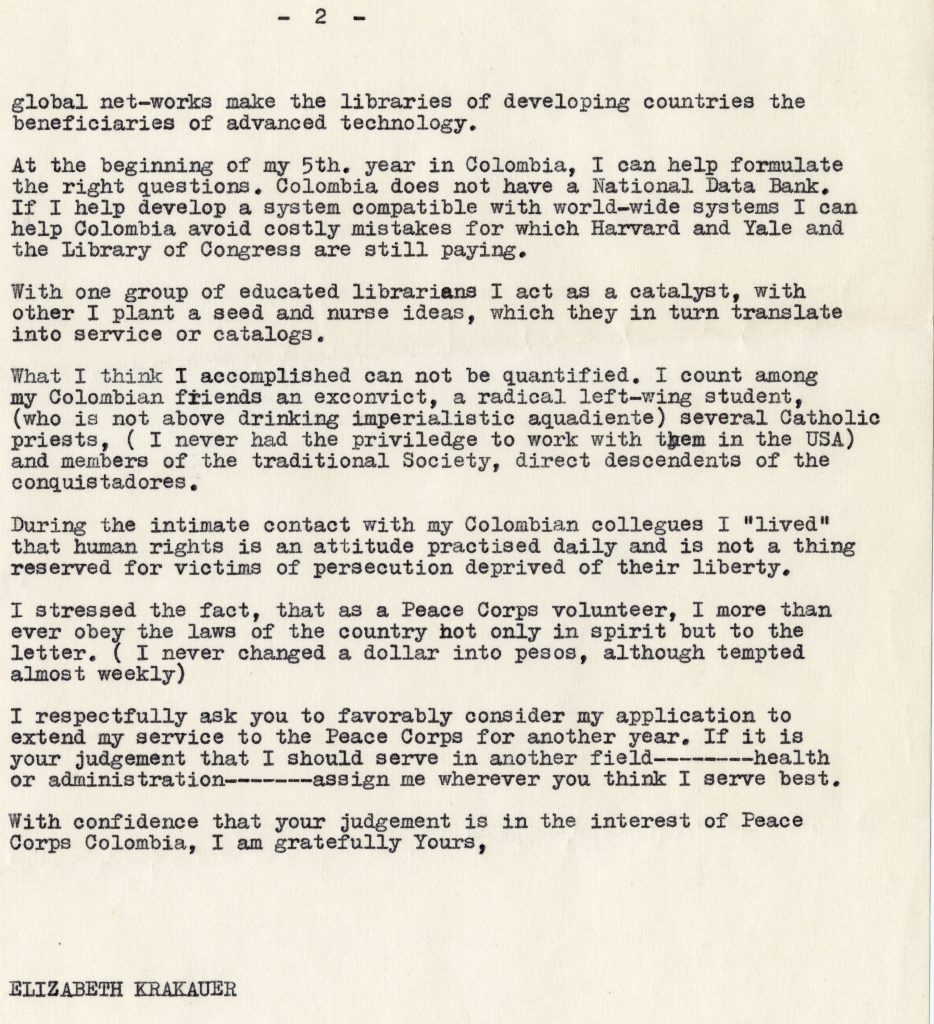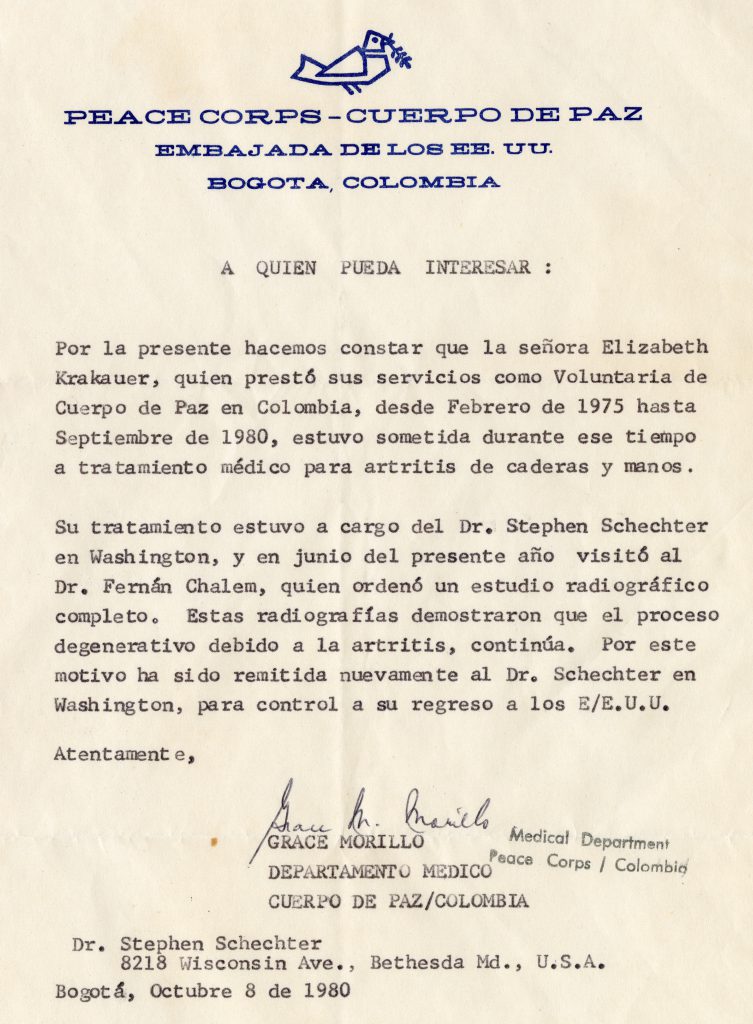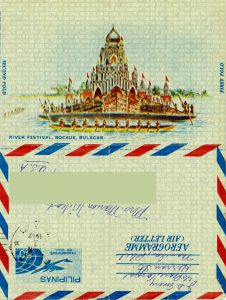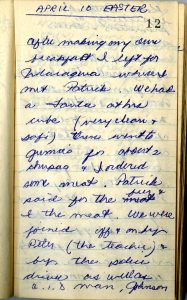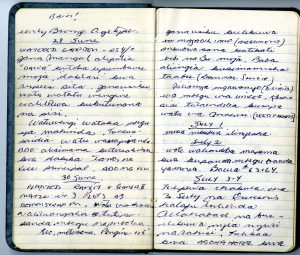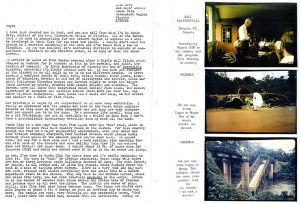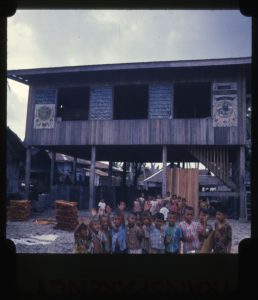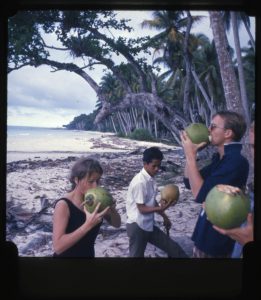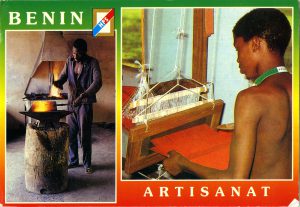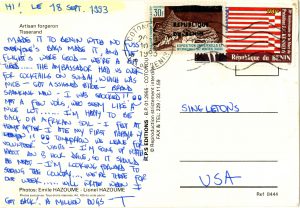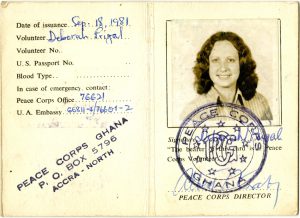As the age of imperialism ended, new governments formed throughout the post-colonial world. These newly autonomous nations developed in the shadow of the Cold War, which set the tone for their foreign policy. Communist and capitalist powers alike sent aid to develop and influence these nations. All nations that sent aid held agendas; they desired the political advantage that came with influence in the developing world. However, these newly formed nations held agendas of their own, such as an automatous, effective government and the ability to determine their own culture. Native citizenry worked towards these goals while as they accepted foreign aid. Collections from four volunteers who experienced the extreme example of this self- determination, revolution, informs this essay and clarify the relationship between self-determined culture and foreign aid.
The Peace Corps was contemporary with other development volunteering impulses. Peace Corps Volunteers (PCVs) met volunteers from post-imperial, capitalist, and communist countries, which each had an interest in relations with the developing world. Sometimes, relations between volunteers were professional. On 16 August 1971, Gail Wadsworth (Uganda, 1971-73) wrote about her British colleague,
She’s quite nice but very anxious to return to England. After one semester of teaching I’ll be second in experience in the English Department. The turnover of teachers throughout the country is fantastic. British contract usually come out for 2 years.[1]
Other times, the relationships were friendlier. Wadsworth wrote on 15 December 1971, “There is a Danish volunteer here now, Ellen Knudson, 28 yrs. She wants me to go on a trip with her and I’ve just about decided to go.”[2] Ann Hofer Holmquist (Nigeria, 1966-68), too, mentions befriending and traveling with British volunteers to Niger.[3] Such friendly relations typically developed between PCVs and other Western-bloc volunteers.
The Western-bloc were not, however, the only nations that took part in projects to develop gain political favor with the post-colonial world. Projects led by communist nations were present in Uganda during Wadsworth’s stay. On 16 September 1917, she wrote, “Just outside of Tororo the Russians are building a farm school which is supposed to be staffed by Russian teachers. That could be really interesting if I could get to meet them.”[4] This school appeared in another letter the next month, “The President is in Tororo again today. There is a tractor mechanic school about 18 miles out, built & staffed by the Russians. He came to open that.”[5] This was not the only communist-led project in which the president was interested. On 2 October 1971, Wadsworth wrote, “Well, the President or someone decided that the lawn of Tororo Girls School was the best place for the helicopter to land if the President were coming to Tororo. He was coming to Tororo to dedicate a rice paddy (or something) that the Chinese had ‘built’ near here.”[6] This communist presence shows that the development impulse was not an exclusively Western one, and extended across all nations trying to build alliances.
Yet, the host counties had their own agendas for developing both infrastructure and culture. For example, throughout Wadsworth’s service, the Ugandan government grew increasingly nationalist and deported several groups of expatriates. [7] [8] In one letter, she wrote her parents, “The Tororo butcher was Somalian & his 2 brothers were killed 2 months ago in the trouble in Moroto. He just gave up on this place & went to Somalia. Now there is no meat in town.”[9] In addition to purifying the Ugandan race, the government also implemented policies to purify Ugandan culture. In June 1972, Wadsworth wrote,
Well, the most talked-about news here these days is that hot pants, mini skirts, & v-split maxis have been banned. The announcement was made last Saturday and 10 days were given, so it officially goes into effect next Monday. The police will enforce it then but ‘people’ are doing so now.[10]
Such measures show that the citizenry of host nations determined their own cultural development.
Nationalist sentiments and a citizenry’s desire to develop their nation could also lead to revolution. Though this discontentment focused on the government and not at foreign aid, circumstances sometimes progressed to the point where evacuation was necessary. Wadsworth was evacuated from Uganda, as was Geer Wilcox (Dominican Republic, 1963-65) when the Dominican Civil War grew too dangerous.[11] Holmquist was present for the Nigerian Civil War, but because the fighting stayed distant she stayed in Nigeria. In her tapes, she spoke against the need to fight, comparing internal skirmishes to those of the European Medieval Era that only weakened the nation.[12] Finally, Debby Prigal (Ghana, 1981-83) experienced difficult conditions both before and after the coup. Ghana had had unpredictably stocked shops,[13] the world’s most over-valued currency,[14] and an incredibly unreliable postal system. After the coup took place, Prigal wrote home,
I am perfectly fine; there has been a coup. There is no reason to worry. Things are perfectly normal. Tell everyone I’m fine.
I will write but I’m not sure how the mail will be. At this point the borders are closed but when they open up I’ll try to get a letter through.
I had a nice vacation and school is supposed to start next Monday. Things are quiet here; there is a curfew but that is about all.
All’s well.[15]
Things returned to normal quickly and Prigal returned to work. On 26 July 1982, she wrote home, “Sister Mary told me that 9 out of 12 of my students passed their ‘A’ level math. The national average is 30%. Last year 7 out of 9 failed, so she is happy.”[16] Together, these experiences show that in these instances governments were changed due to native address of deep-rooted systemic flaws. Whether the Peace Corps perpetuated the problem, as was the case in Uganda, or was merely a symptom of much larger problems, such restructuring shows that host nations continued to develop themselves, even as foreign aid was accepted.
At once, nations self-identified as ‘developed’ offered aid to the developing world and the developing world also took great pains to develop itself. While these goals are fundamentally aligned, there are nuances in their implementation which caused tensions between the foreign aid and the desire for development by the governed. One tension resulted from an integral conservatism in foreign aid. Foreign aid is given by a government to a government. The prerequisite understanding of the aiding government is that the aided government will remain consistent and that aid will be given within such parameters. However, there were times when development aid was not enough for the native citizenry; to function as a collective, their government itself had to change to reflect the needs of the people. A second friction can be seen in the cultural development. While a PCV can work on projects determined through partnership of the two governments, they cannot develop the local culture, such as arts, fashion, and crafts. This development had to be done by the native people, seen here most prominently in the Ugandan desire to be rid of all expatriates. Such tensions are a part of any foreign aid endeavor and can to a greater or lesser extent determine the usefulness and impact of foreign aid to a partner nation. The examples here show that such aid is often coveted and necessary, yet only within the prerequisites of an independently functioning government and a vibrant local culture.
[1] Letter, Gail Wadsworth to Mr. & Mrs. C. M. Wadsworth, 16 August 1970, Peace Corps Community Archives: Gail Wadsworth, Box 1, Folder 4: Correspondence 1969-71 (1/2) Uganda 1970-72, American University Archives and Special Collections, American University Library.
[2] Letter, Gail Wadsworth to Mr. & Mrs. C. M. Wadsworth, 15 December 1971, Peace Corps Community Archives: Gail Wadsworth, Box 1, Folder 5: Correspondence 1971-72 (2/2) Uganda 1970-72, American University Archives and Special Collections, American University Library.
[3] Audio recording, Hofer Holmquist, Peace Corps Community Archives: Hofer Holmquist, Box 1, Reel 9727, Side 2, American University Archives and Special Collections, American University Library.
[4] Gail Wadsworth to Mr. & Mrs. C. M. Wadsworth, 16 August 1970.
[5] Letter, Gail Wadsworth to Mr. & Mrs. C. M. Wadsworth, 26 September 1971, Peace Corps Community Archives: Gail Wadsworth, Box 2, Folder 5: Correspondence 1971-72 (2/2) Uganda 1970-72, American University Archives and Special Collections, American University Library.
[6] Letter, Gail Wadsworth to Mr. & Mrs. C. M. Wadsworth, 2 October 1971, Peace Corps Community Archives: Gail Wadsworth, Box 1, Folder 5: Correspondence 1971-72 (2/2) Uganda 1970-72, American University Archives and Special Collections, American University Library.
[7] Letter, Gail Wadsworth to Mr. & Mrs. C. M. Wadsworth, 16 August 1970, Peace Corps Community Archives: Gail Wadsworth, Box 1, Folder 4: Correspondence 1969-71 (1/2) Uganda 1970-72, American University Archives and Special Collections, American University Library.
[8] Uganda being a developing country there is a definite need to create a “national” character. This is particularly difficult here with the number of tribes in this country. Ceclaring English as the national language was one attempt at this, but there is also a lot of pressure to change it to Kiswahili. Neither English nor Kiswahili is native to Uganda, but Luganda is too closely connected with the Baganda people. There is also being initiated a National Service which would require all educated personas to donate 2 years to the service of the country.
Also the Indians run most of the shops. Many of the Indians were born here. Some have British, or Indian, or Ugandan citizenship, but some have no citizenship. Well, beginning this month the government has been moving in, taking over the shops & turning them over to Ugandans, and deporting the Asians. My Asian students told me that they all had to be out of the country by next March. The Kenyans are being returned to Kenya between September & December. Peace Corps may be next on the list. AID is pulling out by December 1971, after which Tororo Girls School will have no more American contract teachers.
[9] Letter, Gail Wadsworth to Mr. & Mrs. C. M. Wadsworth, 3 September 1971, Peace Corps Community Archives: Gail Wadsworth, Box 1, Folder 5: Correspondence 1971-72 (2/2) Uganda 1970-72, American University Archives and Special Collections, American University Library.
[10] Letter, Gail Wadsworth to Mr. & Mrs. C. M. Wadsworth, 1 June 1972, Peace Corps Community Archives: Gail Wadsworth, Box 1, Folder 5: Correspondence 1971-72 (2/2) Uganda 1970-72, American University Archives and Special Collections, American University Library.
[11] Audio recording, Geer Wilcox, Peace Corps Community Archives: Geer Wilcox, Box 1, 38a, American University Archives and Special Collections, American University Library.
[12] Ann Hofer Holmquist, Reel 9727, Side 2.
[13] Letter, Debby Prigal to the Van de Nove’s & the Prigals, 25 July 1981, Peace Corps Community Archives: Debbie Prigal, Box 1, Folder 7: Ghana 1981-1983 Letters to Debby’s Parents 9/17/81-5/15/83, American University Archives and Special Collections, American University Library.
[14] Letter, Debby Prigal to the Prigal Family, 17 September 1981, Peace Corps Community Archives: Debby Prigal, Box 1, Folder 7: Ghana 1981-1983 Letters to Debby’s Parents 9/17/81-5/15/83, American University Archives and Special Collections, American University Library.
[15] Letter, Debby Prigal to Everyone, 4 January 1982, Peace Corps Community Archives: Debby Prigal, Box 1, Folder 7: Ghana 1981-1983 Letters to Debby’s Parents 9/17/81-5/15/83, American University Archives and Special Collections, American University Library.
[16] Letter, Debby Prigal to Mom & Dad, 26 July 1982, Peace Corps Community Archives: Debby Prigal, Box 1, Folder 7: Ghana 1981-1983 Letters to Debby’s Parents 9/17/81-5/15/83, American University Archives and Special Collections, American University Library.

